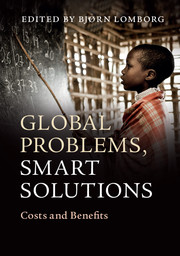Book contents
- Frontmatter
- Contents
- List of Figures
- List of Tables
- List of Contributors
- Acknowledgments
- Selected abbreviations and acronyms
- Introduction
- Part I The Solutions
- 1 Armed Conflicts
- 2 Ecosystems and Biodiversity
- 3 Chronic Disease
- 4 Climate Change
- 5 Education
- 6 Hunger and Malnutrition
- 7 Infectious Disease, Injury, and Reproductive Health
- 8 Natural Disasters
- 9 Population growth
- 10 Water and Sanitation
- 11 Corruption and Policy Reform
- 12 Trade Barriers and Subsidies
- Part II Ranking the Opportunities
- Conclusion: Making Your Own Prioritization
- Index
- References
5 - Education
Published online by Cambridge University Press: 05 June 2014
- Frontmatter
- Contents
- List of Figures
- List of Tables
- List of Contributors
- Acknowledgments
- Selected abbreviations and acronyms
- Introduction
- Part I The Solutions
- 1 Armed Conflicts
- 2 Ecosystems and Biodiversity
- 3 Chronic Disease
- 4 Climate Change
- 5 Education
- 6 Hunger and Malnutrition
- 7 Infectious Disease, Injury, and Reproductive Health
- 8 Natural Disasters
- 9 Population growth
- 10 Water and Sanitation
- 11 Corruption and Policy Reform
- 12 Trade Barriers and Subsidies
- Part II Ranking the Opportunities
- Conclusion: Making Your Own Prioritization
- Index
- References
Summary
Introduction
The World Bank's first effort to spur educational investments in children was in Tunisia in 1962. At that time, 41 percent of the world's children aged 6–11 were not in school. In SSA, only 25 percent of primary-aged children were in school, while enrollment rates in the Arab States (39 percent) and South Asia (44 percent) were only modestly better. Their parents were not in a position to produce the education in the home – only one-third of the adult population in low-income countries were literate and the average adult education level was 1.6 years. Even in middle-income countries, about 20 percent of the primary-aged children were not in school, and one-third of their parents were illiterate with an average education level of 2.8 years. Given the overwhelming evidence that literacy and schooling can improve health and economic outcomes, the World Bank's focus was on expanding the supply of available schools and qualified teachers.
Over the next forty-nine years, the World Bank has invested $69 billion around the world to increase schooling outcomes in developing countries. Schooling outcomes have improved dramatically in the developing world over that time. Only 10 percent of primary-aged children are not in school. The enrollment rates in the Arab States (86 percent) and South Asia (91 percent) are more than double the rates in 1960. Of the primary-aged children out of school in these regions, just over half will never attend school while the rest have either dropped out after attending for at least some years or will enter eventually. Consequently, primary completion rates are approaching 90 percent or more in these areas, as they are in the world as a whole.
Information
- Type
- Chapter
- Information
- Global Problems, Smart SolutionsCosts and Benefits, pp. 273 - 331Publisher: Cambridge University PressPrint publication year: 2013
